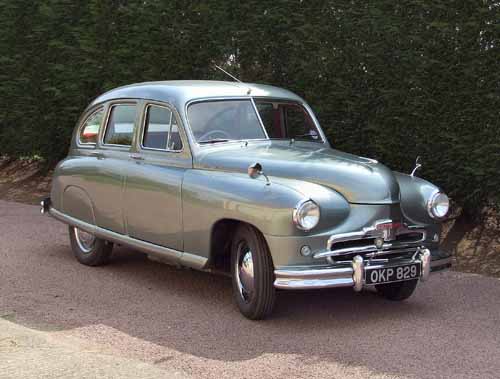For most of the 1930s and into the early 1940s automobile stylists assumed that the car of the future would feature teardrop streamlining.
It turns out that Harley Earl, General Motors' styling supremo from the late 1920s to the late 1950s, decided that the teardrop motif wouldn't do for his restyled 1948 and 1949 models. And in those days, GM styling ruled because the corporation claimed half the U.S. car market.
Due to either ignorance of Earl's plans or stubbornness, a few car makers went ahead with teardrop-inspired designs featuring "fastback" upper styling and fenders flush to the car's body and extending from headlamp to taillight. Some European car companies did the same thing.
Earl's styling judgment eventually failed him starting with the 1957 model year Buicks and Oldsmobiles. But he was on target in the late 1940s, deciding that teardrop styling resulted in cars with a distinctly bloated, awkward appearance; his 1948 and 1949 restyled lines were much more graceful and sold well. Competing lines that opted for the teardrop approach tended to look like bathtubs turned upside-down.
Gallery
Packard - 1948
The 1948 Packard was a major facelift of a fine 1942-vintage design. The most visible change was replacing distinct front and rear fenders with an awkward single fender bulge extending the length of the body. Sales were good the first year, but rapidly deteriorated thereafter.
Hudson - 1948
Hudson's postwar restyling was probably the most successful of the examples pictured here. That was partly because the cars really were low and partly because the crease along the side of the fender helped further lower the car's appearance.
Lincoln Cosmopolitan - 1949
The 1949 Lincolns used two different bodies. The one shown at the top of this advertisement was shared with Mercury. Its fender line stepped down from front to rear and counteracted the potential side bulk common to most cars of that period. The other car was the Cosmopolitan which had a larger, Lincoln-only body. Most Cosmos featured a "bustle back" style where the top stepped down to a distinct trunk at the rear. But for 1949 some Cosmos featured a "fastback" rear roofline in the teardrop fashion, and that's what's shown at the bottom. Fastback Cosmos sold poorly and the variant was scrapped.
Nash Airflyte - 1949-50
To me, the Nash was the archetypical upside-down bathtub design. Besides the heavy, rounded top, wheel openings were minimal and that made the sides look more ponderous than they otherwise might have been. But covered wheel wells were what streamlining was all about back around 1945 when the design was being worked up.
Ford (France) Vedette - 1952
The fenderline of the Vedette is a scaled down version of what is seen on the upper Lincoln in the ad shown above. But some Vedettes had a fastback roofline yielding the awkward appearance seen here.
Borgward Hansa 2400 Sport - 1952-59
Yet another bathtub design, though its heaviness is mitigated a bit thanks to the large windows.
Standard Vanguard - 1952
The British were capable of making some attractive large sedans in the postwar years, but their small ones tended to be unfortunate designs. The Standard Vanguard shown here was truly an awkward, ugly little beast thanks to its short length combined with its roofline and fender styling. I never saw Vedettes or Hansas when I was young, but some Vanguards were sold in Canada and I viewed them in all their ugliness when visiting Vancouver.







2 comments:
I think that the problem here is in trying to make a four-door instead of keeping with the coupe styling. The Porsche model 356 first introduced in 1948 sold very well in the U.S and they kept much of the aerodynamic look for decades afterwards.
There are those of us that find the upside down bathtub design appealing! No, the concept was not a vanguard of future styling but I personally find it more asthetically pleasing than say a Kia Soul , Cube or any 'smart' car. Would love to own a late 40's early 50's Hudson today. It was an era. It was a concept. It was opulent post war America celebrating victory with the fattest, biggest, roundest vehicles in the world. And it was obviously a design that would not sustain itself.
Post a Comment